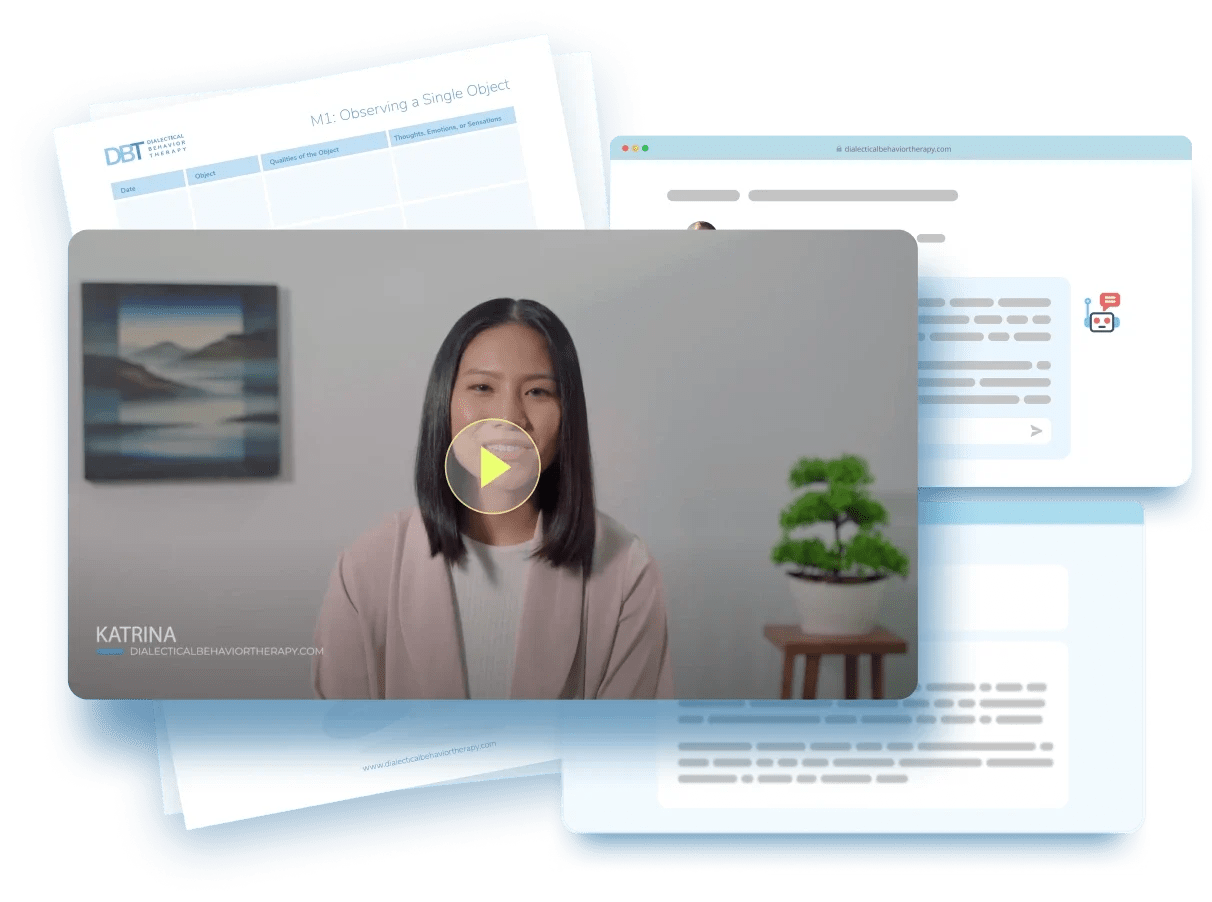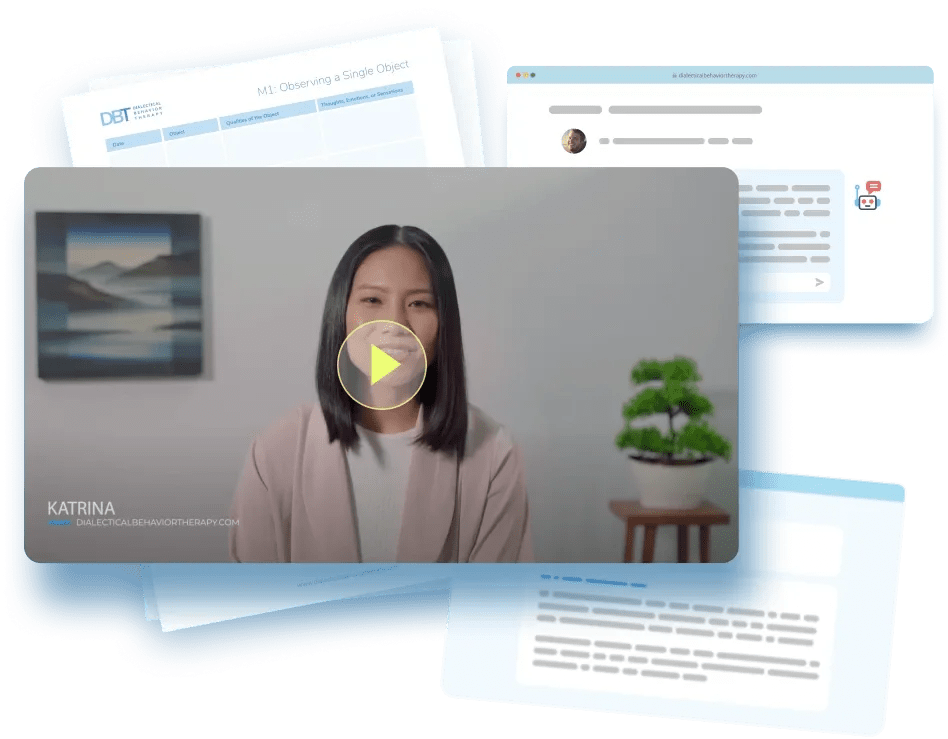What is Problem-Solving, Coping & Relapse-Prevention?
Life can be unpredictable, and stress is a part of almost every day: tight deadlines, difficult conversations, emotional triggers, or unexpected setbacks. When we don’t have a plan to deal with these challenges, it’s easy to fall back on old habits or feel overwhelmed by emotion.
In high-stress moments, our problem-solving skills often shut down. We may react impulsively, avoid the issue, or turn to coping strategies that don’t actually help. Over time, these patterns can build into burnout, relapse, or emotional shutdown.
That’s where coping and planning skills come in.
Problem-solving, coping, and relapse-prevention strategies help you stay grounded under pressure, think clearly when emotions are high, and prepare for challenges before they happen. These skills teach you how to pause, reflect, and respond, rather than react. With practice, you build resilience and regain a sense of control, no matter what life throws your way.
Problem-Solving, Coping & Relapse-Prevention as a CBT Module
Cognitive Behavioral Therapy includes four key modules, with problem-solving, coping, and relapse-prevention serving as the practical application phase. These skills help individuals handle real-world stressors, manage setbacks, and stay on track with long-term change.
Once self-monitoring, cognitive restructuring, and behavioral activation are in place, problem-solving and coping strategies ensure that progress is sustainable, especially in moments of uncertainty, high emotion, or relapse risk.
What Problem-Solving, Coping & Relapse-Prevention Skills are taught in CBT?
The Self-Monitoring & Awareness Skills taught in CBT are "Problem-Solving & Planning" Skills and "Coping & Resilience" Skills.
- 1
Problem-Solving & Planning:These skills help you work through challenges, set achievable goals, and create structure to support long-term change.
- exercise PR1: Five-Step Problem Solver Define–Brainstorm–Weigh–Choose–Plan. A structured approach to solving real-life problems with clarity and intention.
- exercise PR2: STOPP Card Stop. Take a breath. Observe. Pull back. Proceed. A fast, in-the-moment tool for interrupting impulsive reactions and thinking clearly under stress.
- exercise PR7: Relapse-Prevention Plan Create a personalized plan with early-warning signs, an action checklist, and support strategies to help you stay on track when life gets tough.
- exercise PR8: SMART Goal Sheet Turn vague goals into Specific, Measurable, Achievable, Relevant, and Timed steps. Helps you set and follow through on what matters.
- exercise PR10 Weekly Review & Reset Look back at your logs or recent challenges. Pick one small, doable change to try next week. Progress starts with reflection.
- 2
Coping & Resilience: These skills help you manage distress, calm your body, and build emotional resilience, especially in high-stress or triggering moments.
- exercise PR3: Diaphragmatic Breathing Practice the 4–7–8 breathing cycle twice daily to calm your nervous system and reduce anxiety.
- exercise PR4: Progressive Muscle Relaxation Tense and release muscle groups head to toe with a 10-minute audio or script to relieve physical stress.
- exercise PR5: Thought-Stopping Band Use a gentle snap of a rubber band to interrupt intrusive thoughts, and replace them with a more balanced alternative.
- exercise PR6: Stress-Inoculation Imagery Mentally rehearse coping through a tough situation in vivid detail to build confidence before it happens.
- exercise PR9 Self-Compassion Break Pause and say: “This is tough. Others feel this. May I be kind.” A fast reset when self-criticism spikes.
How Do These Problem-Solving, Coping & Relapse-Prevention Skills Help?
The problem-solving, coping, and relapse-prevention skills taught in CBT are designed to help you stay resilient in the face of challenges. They give you tools to think clearly under stress, manage setbacks skillfully, and prevent old patterns from returning.
By learning how to plan ahead, stay grounded in tough moments, and recover quickly when things go off track, you build lasting emotional strength. These skills are key to maintaining progress and navigating life with greater confidence and flexibility.
Benefits of Problem-Solving, Coping & Relapse-Prevention
Even if you are not in therapy, practicing problem-solving and coping skills in your daily life can be highly beneficial. Here are some of the key benefits:
- Increased Resilience. Learning to respond skillfully to challenges helps you bounce back faster from setbacks and manage daily stress with more confidence.
- More Effective Decision-Making. Structured problem-solving helps you weigh options, anticipate consequences, and make thoughtful, values-based choices.
- Improved Emotional Regulation. Coping strategies like breathing, grounding, and self-compassion reduce emotional overwhelm and help you stay calm in tough moments.
- Better Relapse Prevention. Recognizing early warning signs and having a plan in place helps you avoid falling back into old patterns when stress levels rise.
- Greater Long-Term Stability. These skills support consistent habits and progress over time, especially during periods of change, loss, or high emotion.
- Reduced Crisis Reactivity. When problems arise, you’ll be more equipped to respond intentionally rather than react impulsively or avoid them altogether.
- Stronger Self-Efficacy. Solving problems and managing stress effectively builds a deep sense of capability and control over your life.
How to Practice Problem-Solving, Coping & Relapse-Prevention Skills in Real-Life
CBT emphasizes preparing for challenges, managing distress, and staying on track during difficult moments. Here are practical ways to apply problem-solving, coping, and relapse-prevention skills in daily situations.
Practice STOPP before reacting. When you feel overwhelmed or triggered, pause and mentally walk through STOPP: Stop, Take a breath, Observe, Pull back, Proceed. It helps you interrupt impulsive reactions and think more clearly.
Break problems into steps. If something feels too big to handle, use the Five-Step Problem Solver: define the issue, brainstorm options, weigh pros and cons, choose a path, and create a small action plan. Even one step forward builds momentum.
Rehearse your response in advance. Use a Coping-Ahead Script to mentally walk through a situation you’re worried about. Picture what you’ll think, feel, and do. So you’re ready, not reactive, when it happens.
Review and reset weekly. Take a few minutes each week to reflect on what went well, what triggered stress, and what you want to adjust. This helps prevent small setbacks from turning into bigger spirals.
Subscribe.
Get the DBT course. Free!
Get your full access to our 26-week DBT course.
Lessons emailed to you twice a week.

Frequently Asked Questions
Problem-solving in CBT helps you break down overwhelming challenges into manageable steps. The goal is to think clearly under pressure, generate realistic solutions, and take thoughtful action, especially when emotions are high or motivation is low.
Relapse-prevention involves identifying early warning signs, high-risk situations, and unhelpful thinking patterns that could trigger a setback. Then, you build a personalized plan with coping strategies and support tools to stay on track when stress hits.
That’s where coping skills come in. CBT teaches you to pause, ground yourself, and regulate your body and mind during moments of distress. Techniques like STOPP, breathing, and self-compassion help you regain calm so you can respond instead of react.
Not at all. While relapse-prevention is often associated with addiction recovery, it’s just as important for managing anxiety, depression, burnout, and emotional patterns. It’s about building long-term resilience, not just avoiding relapse.
References
- D’Zurilla, T. J., & Nezu, A. M. “Problem-Solving Therapy: A Positive Approach to Clinical Intervention” (3rd ed.). Springer Publishing Company. (2007).
- Meichenbaum, D. “Stress Inoculation Training.” Pergamon Press. (1985).
- Marlatt, G. A., & Donovan, D. M. (Eds.). “Relapse Prevention: Maintenance Strategies in the Treatment of Addictive Behaviors” (2nd ed.). The Guilford Press. (2005).
- Linehan, M. M. “Cognitive-Behavioral Treatment of Borderline Personality Disorder.” The Guilford Press. (1993). (Includes relapse-prevention and crisis coping strategies adapted into CBT from DBT)
- Nezu, A. M., Nezu, C. M., & D’Zurilla, T. J. “Problem-Solving Therapy: A Treatment Manual.” Springer Publishing Company. (2013).



